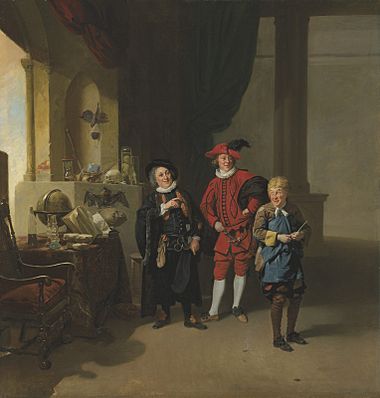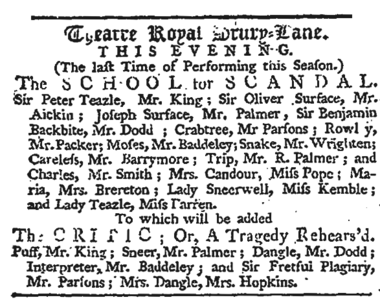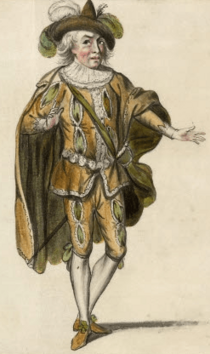William Parsons (actor) facts for kids
William Parsons (born February 29, 1736 – died February 3, 1795) was a British actor and painter. He lived in the 1700s and was known for his work on stage. He often performed at famous theaters like Drury Lane and Haymarket. While he played many smaller parts, he also had important roles in plays such as Volpone and Hamlet.
Contents
Early Life and First Steps
William Parsons was born in 1736. His father, also named William, was a carpenter in London. His mother, Elizabeth, came from Maidstone.
Parsons went to St Paul's School. There, he learned from Sir Henry Cheere, a surveyor. He enjoyed acting in plays with his friends, William Powell and Charles Holland. In 1756, he played the character Kent in the play King Lear at the Haymarket Theatre.
Becoming a Professional Actor
Early Roles on Stage
Parsons's first paid acting job was in the play Earl of Essex by poet Henry Jones in York. During this time, he often acted in comedies and serious tragedies. He learned a lot from an actor named West Digges. Parsons performed at the Theatre Royale Edinburgh in 1757 and 1758. He soon got more roles, including Don Felix in Wonder and Charino in Love Makes a Man.
Rising to More Important Roles

In 1763, Parsons started working with the famous actor David Garrick. Parsons played Filch in The Beggar's Opera at Drury Lane. Over the years, Parsons appeared in more than 200 plays at Drury Lane. Most of these were supporting roles, meaning he helped the main actors.
In January 1765, Parsons played the first Nicodemus in Elizabeth Griffith's play Platonick Wife. Later that year, he first appeared at the Haymarket as Dr. Catgut in Foote's The Commissary. Parsons often performed at the Haymarket during the summer. He helped introduce new characters in new comedies. That season, he also played Douglas in Henry IV, Part 1 and Rosencrantz in Hamlet.
Parsons started taking on more unique character roles. These included the servant Blunt in The London Merchant and Lord Plausible in Plain Dealer. He also played Gobbo in The Merchant of Venice and Sir William Meadows in Love in a Village.
In 1767, Parsons took on one of his most important roles: Polonius in Hamlet.
Acting in the 1770s
In 1773, Parsons played his first Christmas role as Faladel in Christmas Tale. He continued to play new characters in different plays. In the 1770s, Parsons took on military roles, like the General Worry in Rival Candidates. He also played Justice in Runaway and Colonel Lovemore in Contract. These roles brought him back to the Haymarket in 1776.
During the 1776–77 season, Parsons continued to create new characters at Drury Lane. He played Sir Jacob Thrift in Hotel or Double Valet and Doctor Probe in Trip to Scarborough. He also played the gossipy Crabtree in The School for Scandal. Parsons also returned to the Haymarket, playing Tony Lumpkin in Tony Lumpkin in Town.
As the 1770s ended and the 1780s began, Parsons was performing in plays like The Lord of the Manor.
Later Acting Career

Later in his career, Parsons often played characters involved with the law. He was an attorney in Divorce and a Justice in Love in a Village and A New Way to pay Old Debts. He also played Bale in Fair American.
Parsons appeared as Twitch in The Good-Natur'd Man. Other plays he performed in included The Clandestine Marriage, Measure for Measure, and Variety. In 1784, a newspaper reviewer praised his performance as Lord Ogleby in The Clandestine Marriage. The reviewer said Parsons was a "very favourite actor" whose talent was "extensive."
Unlike earlier in his career, Parsons played fewer new characters in his later years. However, he did introduce some new roles at the Haymarket. These included Johnny Atkins in Mogul Tale or the Descent of the Balloon and Squire Codger in Beggar on Horseback. He also played Mr Euston in I'll tell you What and the servant Rohf in Disbanded Officer. Parsons also played Sir Christopher Curry in Inkle and Yarico and Alscrip in The Heiress. Many of these roles were for characters who were not very important or were a bit silly.
Even in his last years, Parsons kept acting. He appeared as Cobb in Poor Old Drury and Old Manly in Fugitives in August 1792. His very last original role was Lope Tocho in Mountaineers at the Haymarket Theatre in June 1792.
After playing Moneytrap in Confederacy, Parsons performed his final role: Sir Fretful Plagiary in The Critic.
Acting Style
William Parsons was known for his cleverness and his ability to speak loudly and clearly on stage. While other actors might have been good singers, Parsons used his mental skills to stand out. His performances in plays like Peeping Tom, Volpone, The Confederacy, and The Village Lawyer showed his unique talents.
Parsons was especially good at playing older men, like Whittle in Irish Widow and Colonel Oldboy in Lionel and Clarissa. He also excelled at playing country clowns, such as Scrub in The Stratagem.
In 1812, a writer for Biographia Dramatica called Parsons a "comic actor of superlative merit." The writer added that Parsons was unmatched in playing characters like Foresight in Love for Love, Corbaccio in Volpone, and Sir Fretful Plagiary in The Critic.
Painting Career
Besides being an actor, Parsons was also a talented painter. He even served as a judge for paintings. Parsons showed his artwork at exhibitions held by the Society of Artists and the Free Society of Artists.
His paintings often featured buildings and outdoor scenes. He painted views of Richmond and places like the Spaniards Inn St Paul's, Hampstead, and St George Fields's Frog Hall. Parsons's painting style was influenced by the famous artist Richard Wilson. Parsons knew many important painters of his time.
Parsons also had a hobby of buying old paintings from brokers. He would then sell them later for good prices.
Personal Life and Passing
On September 21, 1762, William Parsons married Mary Price. She was also an actress and had performed with him in The Beggar's Opera. After Mary passed away in 1787, Parsons married again to a woman named Dorothy. Parsons had one son, named Stewart.
William Parsons died on February 3, 1795, at his home in Lambeth. He had been suffering from asthma. He was buried in Lee, Kent, and his tomb has a rhyming poem written on it.



